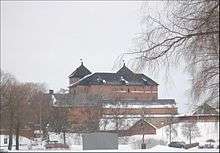Häme Castle



Häme Castle (Finnish: Hämeen linna, Swedish: Tavastehus slott) is a medieval castle in Hämeenlinna, Finland. The castle is located on the coast of lake Vanajavesi in the city center. The castle was originally located on an island. The castle consists of central keep and surrounding curtain walls, surrounded by a moat. The keep has originally had five towers yet only two are today apparent. The curtain wall has a gatehouse, battlements, an octagonal brick corner tower and a round gun tower. The lower tiers of the keep and curtain wall are of masoned granite and upper tiers are red brickwork. The moat is in connection with Lake Vanajavesi and is filled with water.
The castle's age is disputed. Traditionally the construction of the castle has been connected to the legendary Second Swedish Crusade which would date the castle in the mid-13th century. However, there are no finds from the castle that can be firmly dated to a period earlier than 1320s. Also the contents of the crusade legend have been seriously contested. An earlier fortification from about 1300 only some 20 kilometres (12 mi) away in Hakoinen also makes a 14th-century dating for Häme Castle more probable. Only one castle ("Tauestahus") is listed in Tavastia in a royal document from 1308.[1] Also, the Russian Novgorod Chronicle only mentions one castle during their plundering of Tavastia in 1311, its description matching well with the castle in Hakoinen:[2]
The men of Novgorod went in war over sea to the country of the Germans (Swedes), against the Finnish (Yem) people – – And the Germans fell back into the citadel. For the place was very strong and firm, on a high rock, not having access from any side. And they sent with greeting, asking for peace, but the men of Novgorod did not grant peace, and they stood three days and three nights wasting the district.
The construction of Häme castle probably started after the Novgorod invasion. The first castle was made of gray stone, and later bricks were used.
The castle lost military importance by the end of the 16th century. Its defensive systems were upgraded in the 18th century with bastions around the castle. The castle became a prison in the 19th century and served as such until 1953, when massive restoration work started. The castle has been a museum since 1988. Facilities can also be rented for private events.
References
- ↑ "Letter by King Birger". Archived from the original on 2007-09-27.. In Latin. Hosted by the National Board of Antiquities.
- ↑ Novgorod Chronicle. English translation.
External links
-
 Media related to Häme Castle at Wikimedia Commons
Media related to Häme Castle at Wikimedia Commons - Official site: Häme Castle at the Finnish National Board of Antiquities
- Medieval castles in Finland, thisisFINLAND.fi
- Hame Castle at fortified-places.com
Coordinates: 61°00′14″N 024°27′29″E / 61.00389°N 24.45806°E